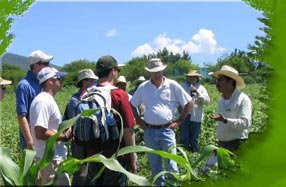September, 2004
 Five undergraduate biology students from Truman State University in Kirksville, Missouri, visited CIMMYT headquarters for four days in August to learn about CIMMYT’s research and observe scientists working in an international environment.
Five undergraduate biology students from Truman State University in Kirksville, Missouri, visited CIMMYT headquarters for four days in August to learn about CIMMYT’s research and observe scientists working in an international environment.
“What they are doing at CIMMYT is on the cutting edge in the molecular aspects, as well as in the traditional breeding programs,” says student Benjamin Schmidt. “Everyone we met was friendly and helpful in explaining the centers’ goals and how they hope to accomplish them.”
Scientists in the Applied Biotechnology Center gave presentations to the students about their research and also provided constructive criticism and new perspectives on the research presentations given by the students. “The best part was the scientists’ willingness to hear about our research and share their research with us,” says student Christopher Spencer.
Their research project, entitled “High-Density Genetic Map of Maize Transcripts,” focuses on comparing the genetic map of thousands of sequenced maize genes to the completely sequenced rice genome. The National Science Foundation grant that funds the project is aimed partly at exposing students to the international scientific community and the challenges faced by scientists who genetically improve plants for the developing world.
Dr. Brent Buckner, the students’ biology professor, thinks the trip’s highlight was a visit to CIMMYT’s subtropical field station in Tlaltizapán. “It was at this point that the students truly came to understand the marriage between laboratory science, plant breeding, and developing maize and wheat to combat world hunger,” says Buckner, who directs their research project.
“It was exciting to see firsthand the field projects that supported and complemented the laboratory projects that had been described to us on the first day, and to which the students had contributed during their shadowing experience,” says Buckner. “CIMMYT was an outstanding place to expose students to how classical breeding methods and molecular genetic techniques are being used together to improve agriculturally important crops.”
After visiting the experiment station, the students met with a local farmer who shared his methods for growing hybrid maize for his family’s consumption. “Seeing a Mexican farmer utilizing the science in the field drove home what the research is all about,” says student Ryan Douglas.
The students toured the Plant Genetic Resources Center, CIMMYT’s germplasm bank, learned about the domestication of wheat and genetic diversity of maize, and shadowed technicians in biotechnology laboratories. They saw the importance of maize in Mexico’s history and culture when they visited the Pyramids of Teotihuacan and the National Museum of Anthropology in Mexico City. The trips emphasized the link between maize cultivation and human development in Mexico, and the role grains have played in civilization.
“This is exactly what I was hoping for from this trip—the chance to interact with the people who make everything happen,” says student Kristen Haley. “I think the experience overall gave us a better understanding of the processes and a broader view of the project’s impact.”
Information for this article was provided by Kendra Knoll, a senior in communications science at Truman State University.

